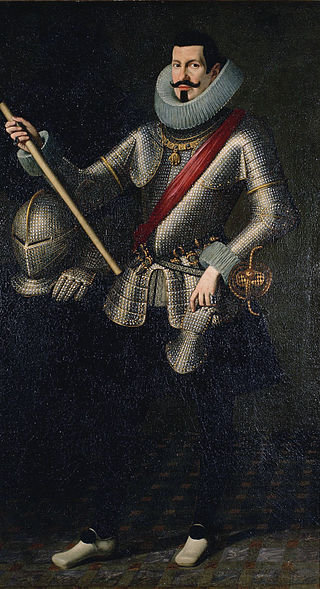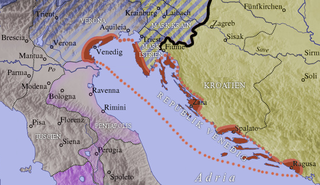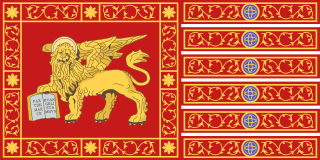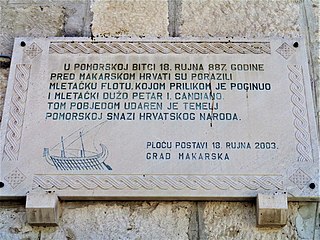
The Treaty of Madrid was a peace treaty between the Republic of Venice and the Habsburg monarchy, ending the Uskok War. Its indirect consequence was the elimination of Uskok piracy in the Adriatic Sea.

The Treaty of Madrid was a peace treaty between the Republic of Venice and the Habsburg monarchy, ending the Uskok War. Its indirect consequence was the elimination of Uskok piracy in the Adriatic Sea.
In the aftermath of the Long Turkish War, a large number of refugees settled in the area Senj on the Holy Roman military frontier with the Ottoman Empire. The refugees swelled the ranks of Uskoks, a type of irregular militia that conducted cross border raids upon the Ottomans. Apart from their raiding activities, the Uskoks did not shy away from piracy, attacking ships without regard towards the ethnic background or religious affiliation of their crews. In 1606, the Ottomans and Holy Roman Empire signed the Treaty of Zsitva-Torok which prohibited cross border raiding across the two states. In 1615, the treaty was renewed, prompting more Uskoks to turn towards piracy in the Adriatic Sea. Their activities had negatively impacted the mercantile interests of the Republic of Venice since as far as 1564, which was already aiming to expand its territory towards Habsburg Istria. [1] Venice hired mercenaries in the Kingdom of England and the Dutch Republic, launching blockade of Holy Roman, Adriatic ports. On 20 December 1615, the blockade escalated into the Uskok War with a Venetian invasion of the coastal areas. The Spanish Viceroy of Naples Pedro Téllez-Girón, 3rd Duke of Osuna, intervened into the conflict on the Imperial side, without Spanish approval. The Habsburgs failed to mount an appropriate response as the country faced an internal power struggle. Nevertheless the Venetians were decimated by disease, failing to exploit their numerical superiority. Although negotiations continued throughout the conflict, an agreement was only reached in 1617 with the aid of Spanish, Papal and French mediation. [2] [3]
On 26 September 1617, Imperial diplomat Karl von Harrach became the cosignatory of the Treaty of Madrid along with Venetian ambassadors Giustiniani and Contarini, ending the conflict between the two states. [4] Hostility would continue months after the treaty, however. In November, remaining Uskoks would attack the Venetian survivors shipwrecked in the Croatian coast after the Battle of Ragusa. [5]
The Venetians agreed to the withdrawal of their troops from Imperial territories, while also discharging the English and Dutch mercenaries. The Habsburgs in their turn, agreed to transfer the Uskoks further to the north east by June 1618, while also cutting the number of their forces to 1,000 men. A regular Habsburg garrison was to be established in Senj. The Duke of Osuna remained defiant of both the treaty and the wishes of the Spanish crown, unilaterally continuing his maritime campaign. He was eventually arrested by Spanish authorities in 1620 and convicted of conspiring to become an independent ruler of Naples. Uskoks were either expelled from the empire or resettled deeper into Croatia. The few families that were allowed to stay were closely monitored, ending the Uskok piratical reign. [6] [3]

Ferdinand II was Holy Roman Emperor, King of Bohemia, Hungary, and Croatia from 1619 until his death in 1637. He was the son of Archduke Charles II of Inner Austria and Maria of Bavaria, who were devout Catholics. In 1590, when Ferdinand was 11 years old, they sent him to study at the Jesuits' college in Ingolstadt because they wanted to isolate him from the Lutheran nobles. A few months later, his father died, and he inherited Inner Austria–Styria, Carinthia, Carniola and smaller provinces. His cousin, Rudolf II, Holy Roman Emperor, who was the head of the Habsburg family, appointed regents to administer these lands.

Senj is a town on the upper Adriatic coast in Croatia, in the foothills of the Mala Kapela and Velebit mountains.

Pedro Téllez-Girón, 3rd Duke of Osuna was a Spanish nobleman and politician. He was the 2nd Marquis of Peñafiel, 7th Count of Ureña, Spanish Viceroy of Sicily (1611–1616), Viceroy of Naples (1616–1620), a Knight of the Order of the Golden Fleece since 1608, Grandee of Spain, member of the Spanish Supreme Council of War, and the subject of several poems by his friend, counselor and assistant, Francisco de Quevedo.

The Great Turkish War, also called the Wars of the Holy League, was a series of conflicts between the Ottoman Empire and the Holy League consisting of the Holy Roman Empire, Poland-Lithuania, Venice, Russia, and the Kingdom of Hungary. Intensive fighting began in 1683 and ended with the signing of the Treaty of Karlowitz in 1699. The war was a defeat for the Ottoman Empire, which for the first time lost substantial territory, in Hungary and the Polish–Lithuanian Commonwealth, as well as in part of the western Balkans. The war was significant also for being the first instance of Russia joining an alliance with Western Europe.

The Battle of Sisak was fought on 22 June 1593 between Ottoman Bosnian forces and a combined Christian army from the Habsburg lands, mainly the Kingdom of Croatia and Inner Austria. The battle took place at Sisak, central Croatia, at the confluence of the Sava and Kupa rivers, on the borderland between Christian Europe and the Ottoman Empire.

The Uskoks were irregular soldiers in Habsburg Croatia that inhabited areas on the eastern Adriatic coast and surrounding territories during the Ottoman wars in Europe. Bands of Uskoks fought a guerrilla war against the Ottomans, and they formed small units and rowed swift boats. Since the uskoks were checked on land and were rarely paid their annual subsidy, they resorted to acts of piracy.
The military history of the Republic of Venice started shortly after its founding, spanning a period from the 9th century until the Republic's fall in the 18th century.

Croatian Littoral is a historical name for the region of Croatia comprising mostly the coastal areas between traditional Dalmatia to the south, Mountainous Croatia to the north, Istria and the Kvarner Gulf of the Adriatic Sea to the west. The term "Croatian Littoral" developed in the 18th and 19th centuries, reflecting the complex development of Croatia in historical and geographical terms.

The Republic of Venice was a sovereign state and maritime republic in Northeast Italy, which existed for a millennium between the 8th century and 1797.
The Uskok War, also known as the War of Gradisca or the War of Friuli, was fought by the Austrians, Slovenes, Croats, and Spanish on one side and the Venetians, Dutch, and English on the other. It is named for the Uskoks, soldiers from Croatia used by the Austrians for irregular warfare.

The Second Ottoman–Venetian War was fought from 1499 to 1503 between the Ottoman Empire and the Republic of Venice for control of contested lands in the Aegean Sea, the Ionian Sea and the Adriatic Sea.
Rijeka, formerly known as Fiume, is a city located in the northern tip of the Kvarner Gulf in the northern Adriatic. It is currently the third-largest city in Croatia. It was part of the Roman province of Dalmatia, and later of the Kingdom of Croatia. It grew during the 12th to 14th centuries as a seaport within the Holy Roman Empire, trading with Italian cities. Under the rule of the House of Habsburg from 1466, it was made a free city; and, although part of the Duchy of Carniola, it developed local self-government.

The Hundred Years' Croatian–Ottoman War was a sequence of conflicts, mostly of relatively low intensity, between the Ottoman Empire and the medieval Kingdom of Croatia, and the later Habsburg Kingdom of Croatia. Besides periods of small-scale borderland warfare, the conflict also saw episodes of major conquest campaigns of Croatian land undertaken by the Ottomans especially during the 16th century.
This article presents a detailed timeline of the history of the Republic of Venice from its legendary foundation to its collapse under the efforts of Napoleon.

Venetian Dalmatia refers to parts of Dalmatia under the rule of the Republic of Venice, mainly from the 15th to the 18th centuries. Dalmatia was first sold to Venice in 1409 but Venetian Dalmatia was not fully consolidated until 1420. It lasted until 1797, when the Republic of Venice fell to the forces of Napoleon Bonaparte and Habsburg Austria.

Šumber is a village and ruinous castle in the eastern part of Istria County, Croatia, in the municipality of Sveta Nedelja.

Karl von Harrach was a nobleman, statesman, and diplomat in the Holy Roman Empire. Over the course of his career, he became involved in the internal power struggle over the Holy Roman crown. In 1627, he received the Spanish version of the Order of the Golden Fleece.

The Croatian–Venetian wars were a series of periodical, punctuated medieval conflicts and naval campaigns waged for control of the northeastern coast of the Adriatic Sea between the city-state of Venice and the Principality of Croatia, at times allied with neighbouring territories – the Principality of the Narentines and Zahumlje in the south and Istrian peninsula in the north. First struggles occurred at the very beginning of the existence of two conflict parties, they intensified in the 9th century, lessened during the 10th century, but intensified again since the beginning of the 11th century.

A period of Albanian piracy occurred from the 15th to the 19th centuries, during which Albanian pirates plundered and raided ships. These pirates were based mainly in Ulcinj, but were also found in Bar and Ragusa, and had connections with North Africa.
The Battle of Ragusa was a naval engagement in 1617 between Francisco de Rivera from the Spanish Viceroyalty of Naples and Lorenzo Venier of the Republic of Venice. It resulted in a Spanish and Neapolitan victory.